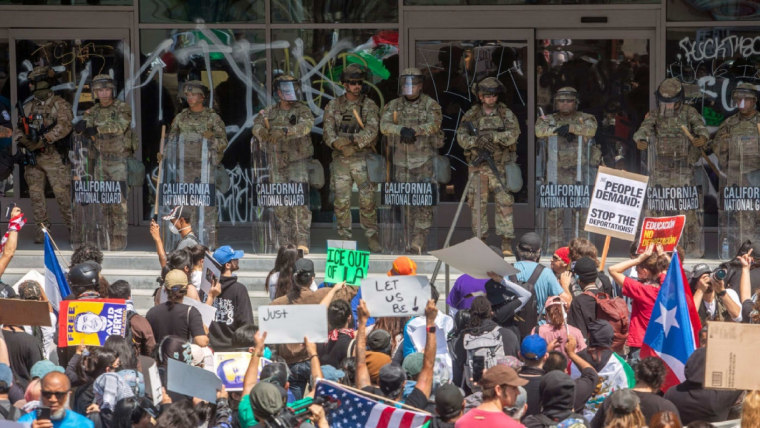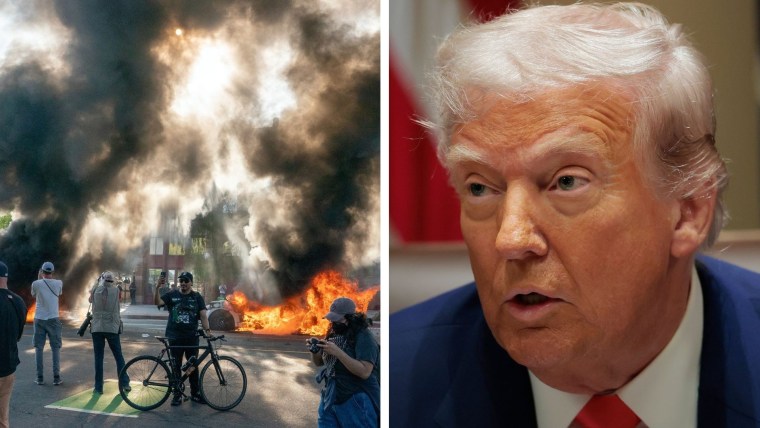President Donald Trump is spoiling for a violent fight on American soil. In response to protests in Los Angeles against his mass deportation regime — a small number of which have turned violent — Trump deployed thousands of National Guard members and roughly 700 Marines. He’s been pining to invoke the Insurrection Act for years, and now that his administration is filled with sycophants, he just might do it.
As Trump flails for a justification to turn the force of the most powerful military in the world on its own citizenry, a tiny but disproportionately destructive element of the L.A. protests is essentially acting in service of Trump’s ambitions to crush dissent.
What should be considered easily and universally condemnable are acts of cowardly and nihilistic violence.
I’m not pearl-clutching about the optics of flying Mexican flags or trying to tone-police protesters’ mean words to cops. I’m not talking about nonviolent lawbreaking or other civil disobedience — which Trump has already, outrageously, likened to violence. And despite the right-wing media panic that Los Angeles is in a state of anarchy, most of the city is completely unaffected by the unrest.
I’m talking about the masked vigilantes beating driverless Waymo cars with their skateboards before setting them ablaze. I’m talking about looting of shoe stores, cannabis dispensaries and an Apple store — among other places of business. Some advocates will deny that arson and theft constitute violence — as long as the impetus for the protest is the correct kind. I disagree, but regardless of what I think, history has shown that most Americans are unlikely to respond positively to such tactics.
What should be considered easily and universally condemnable, however, are acts of cowardly and nihilistic violence. Dropping rocks, bricks and e-scooters off overpasses, throwing Molotov cocktails or shooting commercial-grade fireworks at human beings (whether or not they work in law enforcement) don’t constitute free speech. They’re attempted murder, and they’re unjustifiable.
A spokesperson for Unión del Barrio — an independent Latino political group that organizes workers and immigrants — said in an Instagram video: “What has happened these days weren’t acts of vandalism or crime; they were acts of resistance against a government that is kidnapping our fathers, our mothers, our wives, our husbands, our children.”

Though the organization isn’t speaking for other groups involved in the protests, the aforementioned incidents are indeed crimes, and they make the much larger, peaceful protest movement look dangerous. They undermine the protests’ righteousness against the Trump administration’s overt racism, wanton brutality and relentless lawbreaking. They won’t win any hearts and minds, they won’t liberate people rounded up by ICE agents, and they won’t do anything to thwart Trump’s authoritarianism. Nor will rioters win a street war against the LAPD, much less the Marines.
So what’s the point, other than the vibes?
There have already been reports of law enforcement using excessive force on protesters and journalists. The Los Angeles Times reported that an LAPD helicopter flew over a crowd and announced: “I have all of you on camera. I’m going to come to your house.” And while the American public still generally approves of Trump’s mass deportation policies, the extreme tactics and the choices of targets of ICE’s raids (like green card holders and children) are increasingly less popular. Images of police and the military attacking peaceful protesters won’t increase Trump’s approval ratings.
That’s why activists and community leaders who support the protests need to unequivocally condemn violence and looting. Period. Full stop. To be sure, condemning violence probably won’t stop Trump from doing whatever he’s planning on doing, but if the protests are clearly nonviolent, it’s a lot harder to convince the American people that violent government crackdowns on demonstrations are justifiable.
I covered police and prosecutorial abuses for years as a reporter, including violent law enforcement crackdowns on protests. I witnessed and wrote about unjustified and often brutal assaults by police on demonstrators during the summer 2020 protests following George Floyd’s murder.
Violence isn’t just morally objectionable, it’s strategically foolish in protests against the government.
But I also witnessed incidents of rioting and looting surrounding some of those same protests. These typically occurred after huge groups of peaceful demonstrators had marched through a certain area, trailed by police. Once the main demonstrations and their police escorts left the area, I saw much smaller groups of young men seize the opportunity left by the vacuum of authority. They broke windows, stole merchandise and attacked parked cars. The destruction seemed to be the point.
Many activist leaders and advocates at the time denied what was happening was violence, as if the livelihoods of people working at a small business that was burned to the ground can simply be replaced by insurance reimbursements (which also rarely cover the total value of property lost). Some even attempted to justify rioting by citing the Martin Luther King Jr. quote “a riot is the language of the unheard.”
But they ignored what Dr. King said moments earlier:
“Let me say as I’ve always said, and I will always continue to say, that riots are socially destructive and self-defeating. I’m still convinced that nonviolence is the most potent weapon available to oppressed people in their struggle for freedom and justice. I feel that violence will only create more social problems than they will solve. That in a real sense it is impracticable for the Negro to even think of mounting a violent revolution in the United States. So I will continue to condemn riots and continue to say to my brothers and sisters that this is not the way. And continue to affirm that there is another way.”
The American public, which at first had been overwhelmingly sympathetic to those protests in 2020, began to sour on the demonstrations months later, as they were increasingly perceived as dangerous and out of control. The movement was popular. The violence wasn’t.

Violence isn’t just morally objectionable; it’s strategically foolish in protests against the government.
The hypocrisy of Trump’s sending the Marines into Los Angeles to protect police is off the charts — given his mass pardons of Jan. 6 rioters who brutally attacked Capitol Police. And deploying the military to confront civilians — the same week he’s throwing an ostentatious military parade that just happens to coincide with his birthday — only telegraphs his intentions. Trump’s escalations demonstrate that he wants to provoke demonstrators into violence. It only makes it easier for him to go full authoritarian and to frame violent crackdowns as a necessary remedy to violence.
It’s incredible that this needs to be said, but dropping bricks off of overpasses onto police cars will not make Americans sympathetic to protests against ICE crackdowns, nor will they lead the government to de-escalate. Excusing or justifying any incidents of violence — however rare they might be — in otherwise peaceful protest movements is a losing tactic for winning popular support. And it’s a hopeless tactic to use against the state, which has a legal monopoly on violence.

